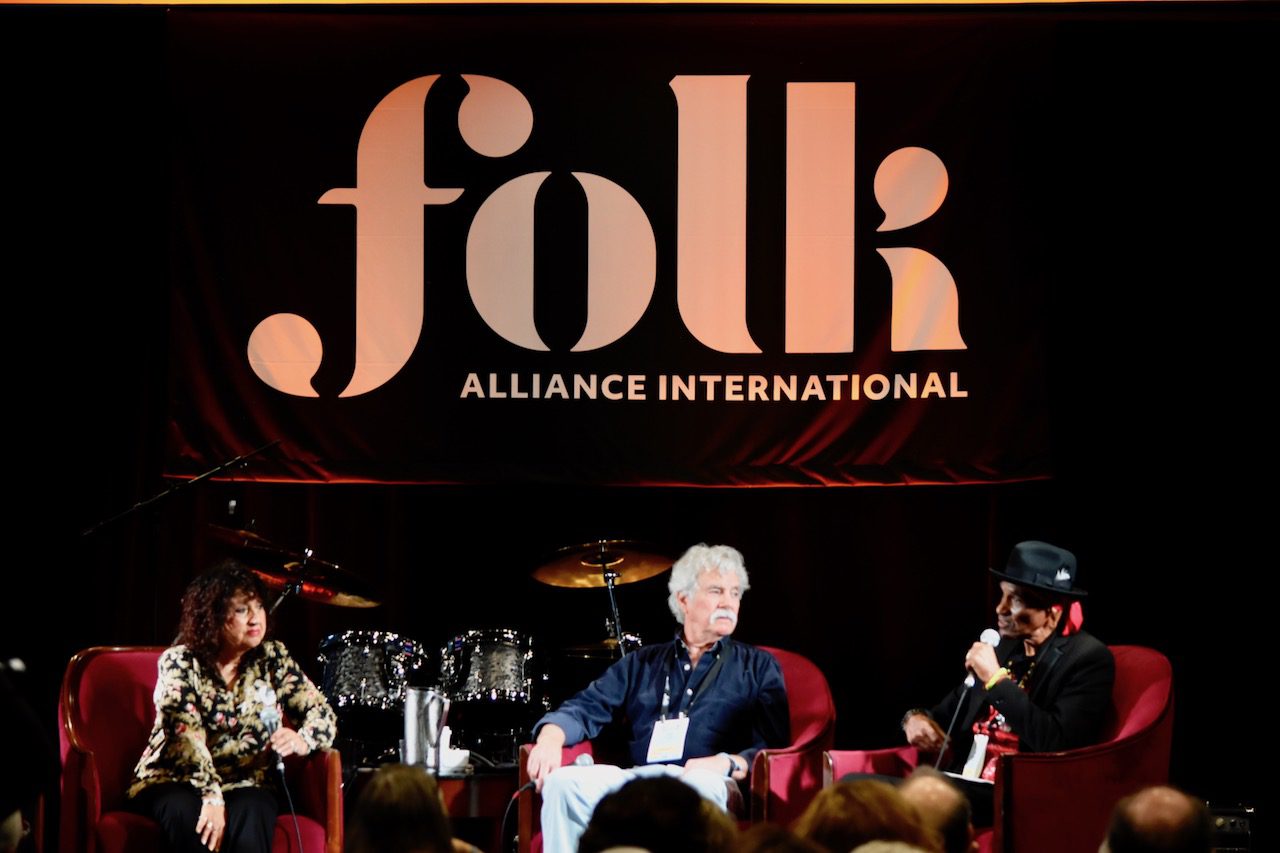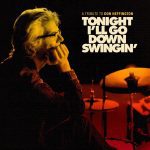THROUGH THE LENS: Invigorating Music, Embracing Diversity – Folk Alliance International 2020

Maria Muldaur, Tom Rush & Cyril Neville - photo by Kim Reed
Folk Alliance International has always held a particular fascination for me, beginning with the word “folk,” a term that was once more broadly used than “Americana” is today. It’s the word we used to describe roots music. In response to a question about the folk music revival of the 1950s, Big Bill Broonzy is reported to have said, “All music is folk music, I ain’t never heard no horse sing a song.”
The seeds of Folk Alliance germinated in Malibu, California, in 1989, and “International” was soon added to the organization’s name. The annual conference has been held in such music-rich locations such as Memphis, Kansas City, and last year’s trek to Montreal. Here is as guest columnist Kim Reed’s report from the 2020 gathering in New Orleans, including photos in the gallery.
The City of New Orleans
Professor Longhair, The Wild Tchoupitoulas, Dr. John, The Meters, Tipitina’s, and Steve Goodman’s “City of New Orleans” all evoke the spirit of this resilient city at the mouth of the Mighty Mississippi. New Orleans was the perfect location last week for this year’s 32nd Folk Alliance International Conference.
This year over 3,000 were in attendance from over 30 countries. In ballrooms, hallways, stairways, and countless hotel rooms, artists from around the world converged on the Sheraton Hotel near iconic Bourbon Street to tell their tales and sing their songs.
Many attendees, especially those visiting NOLA for the first time, made time between sessions and workshops to nip out to explore the French Quarter and beyond for some Cajun food, a beignet, or a tour of this bustling and diverse city. I even ducked out to see Billy Strings at the legendary Tipitina’s one evening.
Diversity
Emphasis on diversity on many levels has always been a priority for Folk Alliance International, and this year it was even more prominent with the inclusion of the “Story of People and Place” segments woven into the the week’s proceedings. Spotlighted this year was the Artist in Residence program. One example of that project resulted from FAI working with the International Rescue Committee to coordinate a collaboration of two of the artists in residence: refugee Raqaya Alfaris and Denver-based Rebecca Folsom. A short video documenting their work and the songwriting process proceeded a stirring performance of the song they created together.
Awards and Keynote Addresses
Local group Cha Wa opened the awards ceremony by playing their way from the back of the ballroom onto the stage. Grayhawk Perkins gave a Land Acknowledgement and welcome. In between the awards — which included Ani DiFranco for the People’s Voice, the venue Preservation Hall for Lifetime Achievement, Ephraim Bugumba for the Spirit of Folk Award, BeauSoleil for the Lifetime Achievement Award, and the Pickathon festival for the Clearwater Award — we were treated to performances by Lula Wiles and Quique Escamilla.
Keynotes during the week came from multi-award winners and activists Mavis Staples and Rhiannon Giddens. Ani DiFranco and Mary Gauthier packed the ballrooms for interviews with NPR’s Ann Powers. All spoke passionately about their work and the paths they had chosen, and, more importantly, they posed their own questions for us to ponder.
Workshops
The topics of the daytime workshops ran the gamut from Festival Rituals, Authentic Stagecraft, Musicians & Migration, and Cajun Fiddle Techniques to strategies for streaming, how to tell folk stories, and the role of video in telling stories. If that wasn’t enough, there were the Cultural Equity Summit and the International Indigenous Summit sessions to attend as well as the Louis Jay Meyers Music Camp for those interested in small group lessons from such accomplished artists as Patty Larkin.
Ballrooms and College Dorms
Each evening began with dozens of performances in ballrooms of the hotel. Áine Tyrrell, Diana Jones, Tanika Charles, Hat Fitz & Cara, The Rainbow Girls, Danny Schmidt & Carrie Elkin, and Cara Dillon all inspired us with their passion and talents. Some rooms were standing room only, while others were less congested and afforded the opportunity to grab more intimate seating.
However, the absolute best part of Folk Alliance are the private showcases. Imagine a handful of floors in a college dorm with the doors wide open, rooms packed to the gills with artists doing short sets, beginning at 10:30 p.m. and many going on till 4 a.m. Not only can you almost sit knee-to-knee with the likes of dynamo Tami Neilson, Amy LaVere & Will Sexton, incredible classical guitarist Gabriel Ayala, Matt the Electrician, Leslie Stevens, Dan Navarro, Catherine Ashby, and Mike Aiken, but you can also discover artists like Calle Sur (the Edgar East & Karin Stein duo), Emerald Rae, and Aussies This Way North.
Veterans of the folk music scene such as Maria Muldaur, Tom Rush, and Cyril Neville shared their stories, while relative newcomers like Kelly Hunt, Scotland’s Iona Grace, Ireland’s Shane Hennessy, and “Acoustic Ninja” Trace Bundy performed their own particular brand of folk music.
Closing
After music day and night for almost a week, most of us make a weary trip home and start to process everything we saw and heard. Some of the musicians will continue out on the road. Many will continue to hone their skills and forge new paths. No, there weren’t enough hours in the day to attend even a fraction of what was offered, and sleep was in short supply for virtually all attendees, but that’s exactly what makes Folk Alliance so vibrant and appealing. I can guarantee you that almost all those who attended Folk Alliance in New Orleans are already looking forward to next year.
Now, Kim’s gallery of photos.
- Mireille Bakhos, Raqaya Alfaris & Rebecca Folsom – Photo by Kim Reed
- Maria Muldaur, Tom Rush & Cyril Neville – photo by Kim Reed
- Allison Russell & Leyla McCalla – Photo by Kim Reed
- Cyril Neville – Photo by Kim Reed
- Tami Neilson – Photo by Kim Reed
- Amy LaVere – Photo by Kim Reed
- Kelly Hunt – Photo by Kim Reed
- Jenna Rae and Martin Ferrell Jr. of Lost Cowgirl Records – Photo by Kim Reed
- Rhiannon Giddens – Photo by Kim Reed
- Cha Wa – Photo by Kim Reed
- Artist in Residence Raqaya Alfaris – Photo by Kim Reed
- Bruce Sunpie Barnes – Photo by Kim Reed
- Michael Doucet of BeauSoleil – Photo by Kim Reed
- Vanessa Mae of The Rainbow Girls by Kim Reed
- Diana Jones – Photo by Kim Reed
- Tami Neilson – Photo by Kim Reed
- Tim Easton – Photo by Kim Reed
- Ann Powers and Ani Difranco – Photo by Kim Reed
- Leslie Stevens – Photo by Kim Reed
- Rhiannon Giddens & Francesco Turrisi – Photo by Kim Reed
- Danny Schmidt & Carrie Elkin – Photo by Kim Reed
- Cara of Hat Fitz & Cara – Photo by Kim Reed
- Catherine Ashby – Photo by Kim Reed
- Hat Fitz & Cara – Photo by Kim Reed
- Damn Tall Buildings – Photo by Kim Reed
- Checking schedules – Photo by Kim Reed
- Gabriel Ayala – Photo by Kim Reed
- Audrey Stone – Photo by Kim Reed
- Cara Dillon – Photo by Kim Reed
- Gwen Thompkins – Photo by Kim Reed
- Charlie Grey – Photo by Kim Reed
- Clementine & Wyatt Easton – Photo by Kim Reed
- Gabriel Ayala – Photo by Kim Reed
- Iona Grace Photo by Kim Reed
- Leisha Jungalwalla of This Way North – Photo by Kim Reed
- Lula Wiles – Photo by Kim Reed
- Colin Lillie – Photo by Kim Reed
- Dan Navarro – Photo by Kim Reed
- Edgar East of Artes Latinas – Photo by Kim Reed
- Emerald Rae – Photo by Kim Reed
- Ephraim Bugumba – Photo by Kim Reed
- Grayhawk Perkins – Photo by Kim Reed
- Indigenous Music Summit Circle – Photo by Kim Reed
- Leslie Stevens – Photo by Kim Reed
- Matt the Electrician – Photo by Kim Reed
- Mike Aiken- Photo by Kim Reed
- Tanika Charles – Photo by by Kim Reed
- Quique Escamilla – Photo by Kim Reed
- Sandra Jaffe Preservation Hall founder – Photo by Kim Reed
- Shane Hennessy – Photo by Kim Reed
- Tami Neilson – Photo by Kim Reed
- Patty Larkin – Photo by Kim Reed
- Billy Strings at Tipitina’s by Kim Reed

























































